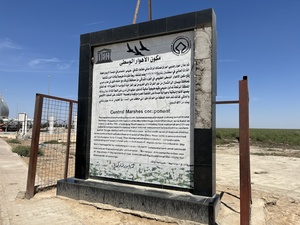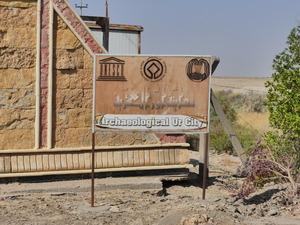Ahwar of Southern Iraq

The Ahwar of Southern Iraq: refuge of biodiversity and the relict landscape of the Mesopotamian Cities covers the marshy delta that was home to the early Sumerian civilization.
The area lies in the joint delta of the Tigris and Euphrates Rivers, which provide arable fields through irrigation. It includes three archaeological sites of urban centers with monumental public architecture (Ur, Uruk, and Tell Eridu) and four wetlands (the Huwaizah Marshes, Central Marshes, East Hammar, and West Hammar Marshes), which are important for bird migration and fish species.
Community Perspective: Probably Iraq's best and most authentic WHS. The first reviewers have focused on the archeological sites, the Ziggurat of Ur being the most appealing monument. Els added one about the Central Marshes, while Clyde enjoyed Uruk.

Map of Ahwar of Southern Iraq
Community Reviews
Clyde

I visited this mixed WHS in September 2024 covering Ur, Uruk (Warka) and the Ahwar Marshes. Like most of Iraq's archaeological sites, the wealth of artefacts found is much more than what is left to see in situ. However, this is perhaps the best group of archaeological sites in terms of authenticity and what's left to see. This applies much more to Uruk than to Ur, although the iconic reconstructed Ziggurat of Ur is a worthy sight.
In Uruk, you literally feel you are trespassing in an archaeological dig, stepping on countless fragments of pottery, cuneiform mud bricks, glazed tiles and conical mosaics. The best time to visit is just before sunset, not only because it is burning hot here earlier, but mostly because all the building remains with glazed tiles and statues (mostly taken to the British Museum and to the Pergamon Museum in Berlin) light up in the afternoon sun. Among the best examples to be explored with a high-clearance car and a generous tip to the caretaker are the Inanna Temple, the Temple of Gareus, and the remains of a ziggurat. Uruk played a leading role in the early urbanization of Sumer in the mid-4th millennium BC, is nicknamed as the birthplace of writing, and possibly gave its name to modern Iraq. It is located east of the current bed of the Euphrates River, on an ancient, now-dried channel of the river. A whole room of artefacts (not to be missed!) has been dedicated to some of the best Sumer finds at the National Museum of Baghdad.
In Ur, the most important monument is certainly the partially restored Ziggurat of Ur. There are also some minor mud brick buildings with a narrow arch, some sealed with bitumen mortar, circular groups of bricks on the floor, and the royal tombs excavation site which led to the discovery of the famous Standard of Ur, several clay sealings, cuneiform tablets and a golden Sumerian headgear and necklaces believed to be of Puabi (on display at the National Museum of Baghdad together with the splendid golden lyres). A bit further from the Ziggurat of Ur are also the remains believed to be those of "Abraham's House" as well as a helipad built for the late Pope Francis' visit, which definitely help to pave the way to the gradual reopening of the Federal Republic of Iraq to tourists beyond Iraqi Kurdistan.
Further South towards Basra lie the Ahwar marshes, home to the Marsh Arabs and abundant birdlife. The welcome breeze on board the narrow motorised boat made the whole boat trip very pleasant, as we startled blond-haired water buffaloes, several stilts, kingfishers, herons and other water birds, and watched the local fishermen drawing or casting their nets, or cooling down in the muddy waters. We ate some delicious fish in one of the few reed houses while we were entertained with some folkloristic Marsh Arab chants.
All in all, I really enjoyed this WHS and I felt it is probably Iraq's best and most authentic WHS.
Els Slots

This should have been split into two WHS: one for the sites of the Ancient Sumerian civilization, one for the “New” Marshes. ICOMOS and IUCN suggested to do so and saw OUV in both, but inscription was rushed through and now we’re stuck with a messy inscription and an unrecognizable site name.
I will focus my review on the Marshes and not on the archaeological sites. These Marshes are the so-called “New Marshes”, which originated about 3,000 years ago when the original marshes near the Sumerian cities dried out and the coastline moved south-east. They have been recognized because of their bird life and the connection to the life of the Marsh Arabs, whose traditional lifestyle was immortalized in the book by Wilfred Thesiger. A visit was included in my tour, but I wondered beforehand whether we would end up at the core zone or an area especially designed for tourists.
Already in the city of Nassiraya the Marshes are signposted with the globally known brown road signs. We drove for 1 hour and 15 minutes to a place where they’ve built a reception area with boats for tourists and a few reed houses. It is near the shiny-silver Martyrs Monument in Chabaish, where at the entrance they even sport a full WHS plaque indicating the Central Marshes component. So core zone it definitely was! The Martyrs Monument commemorates the struggle of the Marsh Arabs against Saddam Hussein, who took a particular dislike to them as they actively rebelled against his regime, are Shia Muslims and led an independent lifestyle. The network of waterways suited itself for guerrilla-style battles, which prompted Saddam to the infamous Draining of the Marshes in the 1990s, meant to eradicate the lifestyle of the Marsh Arabs.
After a short explanation about the life of the Marsh Arabs and a refreshment in the reed “welcome hut”, we went on for a 1.5h tour in narrow, low motorized boats through the Central Marshes. A police boat went ahead of us all the time. The area still has issues with its water levels (the Turkish dam near Diyarbakir is blamed), but it’s a refreshingly green and clean place by Iraqi standards. The people live off buffalo and some tourism, they usually don’t live on the reed islands anymore (they go home to modern comforts overnight). The marshes don’t produce many fish.
Along the channels, still plenty of reed huts are standing, some very pretty in design. We were told that it takes about 10 days to build one and they last for about 10 years. In the past, they added up to 4 layers of reed as a rain cover (now they just add a plastic tarp). We anchored at a reed island where 3 men were tending a couple of buffalo. These huge and ill-tempered beasts are expensive and mostly kept to produce milk.
The boat ride also produced several birds standing on the banks (lapwings, egrets, kingfishers), although the boatmen did not seem to care for them much and certainly weren’t deemed worthy enough for a stop. It’s not hard to imagine, though, that the birds will be happy that these marshes still exist in an otherwise desperately dry region.
Read more from Els Slots here.
Cobaltrage

I visited this region of Iraq in the Fall of 2008. An opportunity arose for myself and some companions to visit the site of the ancient Sumerian city of Ur. I had seen pictures and read about the Ziggurat of Ur since I was a boy so I jumped at the chance. The greatest surprise was how extensive the ruins of the rest of the city are. We parked in the lot at the base of the Ziggurat and climbed up the steps to the top. From there the ruins reached out covering a vast area of the desert. Upon climbing down, we walked towards the rest of the ruins to explore but were stopped at the voice of a man calling to us from a distance. He approached and told us that the rest of the ruins were off-limits. We let him know that we meant no harm and were fascinated by the history of this ancient place. It was then that he introduced himself as Dhaif and explained that he was the caretaker of Ur. He said that his grandfather had been foreman of the workers during the archaeological excavations in 1922 and stayed on the site to take care of it after the British left. His father took over in the 1960's and he took over care of the place in the 1990's. He then offered to give us a tour of the entire place so, of course, we accepted. Over the next hour and a half he showed us the world's oldest known standing arch, the ruins of the palace of King Nebuchadnezzar, the Royal Tombs of Ur, and the House of Abraham. Possessing three generations worth of knowledge on the area, Dhaif was the perfect tour guide. With the wars in the area winding down, I would highly recommend a trip to this location for anyone interested in walking through several thousand years of ancient history.
Thomas Buechler

Ur was once an important Sumerian city state near the mouth of the Euphrates river, at the coast with marshy surroundings and regular floods and adverse weather impacts like erosions.Ur was already occupied as early as 6500 BC during the Urbaid period, but had its peak during the Sumerian period about 3000 BC. Buildings were made out of mudbricks and mud plaster. The main temple, Ziggurat of Ur, was built during king Ur-Nammu reign about 2040 BC. His codes of law (Hammurabi) is the oldest existing deciphered law writing in the world, the original at the Louvre museum, but replicas in many places including the National Museum of Iraq in Baghdad. On the basalt stele are 282 laws including the famous “an eye for an eye, a tooth for a tooth” rules. Ur is also mentioned four times in the Old Testament and in the Book of Genesis as the birthplace of Abraham 2000 BC.The site was first excavated 1853 by the British Museum and the British Vice Consul in Basra who also uncovered the Ziggurat (main temple dedicated to the Moon god Nanna)It was later on reconstructed, including its monumental staircase. However, the third level has collapsed, and its present height is 17 meters from the original of 26. Ur is surrounded by 2 ramparts constructed during Sumerian and Babylonian times. The closest city with infrastructure is Nasariyah, it has decent hotels and restaurants and at present no security problems. We have also visited Uruk where we could talk to German archaeologists at work to stabilize the temples, under the management of the DAI, the German Archaelogical Institute and Margarete van Ess who played a vital role in the conservation of archaeological sites of Babylon, especially Uruk und Ur.
Site Info
- Full Name
- The Ahwar of Southern Iraq: refuge of biodiversity and the relict landscape of the Mesopotamian Cities
- Unesco ID
- 1481
- Country
- Iraq
- Inscribed
- 2016
- Type
- Mixed
- Criteria
-
3 5 9 10
- Categories
- Archaeological site - Near Eastern Natural landscape - Rivers, Wetlands and Lakes
- Link
- By ID
Site History
2016 Advisory Body overruled
ICOMOS & IUCN proposed deferral
2016 Revision
Merger of 2 TWHS: The Marshlands of Mesopotamia & Ur
2016 Inscribed
2015 Postponed
evaluation postponed at the request of the State Party – letter dated 24/08/2014
Site Links
Unesco Website
In the News
Connections
The site has 58 connections
Art and Architecture
Constructions
Damaged
Ecology
Geography
History
Human Activity
Individual People
Literature and Film
Religion and Belief
Science and Technology
Timeline
Trivia
Visiting conditions
WHS Names
WHS on Other Lists
World Heritage Process
Visitors
31 Community Members have visited.
The Plaque
 (photo by Els)
(photo by Els) (photo by Clyde)
(photo by Clyde)